11 Weird & Wonderful Things I Learned In The Galapagos Islands
While most people are aware the Galapagos Islands feature pristine beaches and unique flora and fauna, there are many pieces of information one would have to visit the islands to discover.
Here are some interesting facts I learned when visiting the Galapagos Islands on a solo trip.
1. Soft Sand Is Made Of Fish Feces
Ever wonder how some of the world’s most pristine beaches get such soft sand? While most people say it’s from white coral, if it were that alone the sand would have a very rough texture. What really happens is fish eat organisms out of the coral, digest it, and then excrete it, giving beach-goers the fine, white sand they love.
2. It’s Safe To Swim With Hammerhead Sharks
No, really. For the most part, hammerheads don’t eat people. I tested this theory out (see how far I go for my blog!) in San Cristobal, when I got the chance to swim with sharks at Leon Dormido/Kicker Rock. The water is extremely deep, so of course you can’t see what’s going on in the water until you jump in. Although nervous, I dove in and began treading water with my snorkeling partners. Looking down, we spied two enormous hammerhead sharks a mere 15 feet below us. While I was nervous, the guides just laughed. Apparently, this is no more dangerous than swimming with sea lions.
3. Unlike Humans And Trees, Tortoises Get Smoother With Age
If you’ve ever noticed the circular indentations on a tortoises back, those indicate the animal’s age. Surprisingly, as the tortoise gets older, it begins to lose these circles and gets a smoother shell.
Extra Fun Fact: The tortoises shell is actually made of the same stuff your fingernails are:
Keratin!
This was one of the most interesting facts I learned on my unforgettable Galapagos Islands cruise.
 4. Giant Tortoises Have Very Loud Sex
In San Cristobal, I visited the Jacinto Gordillo Breeding Center of Giant Tortoises. While walking around, I couldn’t ignore an extremely loud, inhuman bellow/scream/cry that repetitively sounded every 15 seconds or so. What I thought was an animal dying was actually a pair of tortoises having sex. They were in a mud pond, and the male had to use a lot of strength to keep climbing on top of the female’s shell. Every time the poor thing thrust, his hands would slip again and he’d have to pull himself back up. The entire time, the female hid terrified in her shell.
Extra Fun Fact: The gender of the baby tortoise is determined by the temperature the eggs are incubated at. If eggs are incubated at 85.1 degrees Farenheit they will be female, and if they’re incubated at 82.4 degrees Farenheit they will be male.
Extra Extra Fun Fact: Baby tortoises must eat their own extrement, or they will die. It’s got certain vitamins and nutrients in it that are necessary to development.
5. Intestines And Blood Make For A Tasty Treat
San Cristobal has some interesting street food. Because many of the cheaper, local restaurants seem to shut down in the evening, I decided to try my luck with whatever the woman in the park was cooking for dinner. For $3, I got a huge helping of potatoes, goat intestines and grilled blood. While it may sound odd, it was actually quite delicious!
4. Giant Tortoises Have Very Loud Sex
In San Cristobal, I visited the Jacinto Gordillo Breeding Center of Giant Tortoises. While walking around, I couldn’t ignore an extremely loud, inhuman bellow/scream/cry that repetitively sounded every 15 seconds or so. What I thought was an animal dying was actually a pair of tortoises having sex. They were in a mud pond, and the male had to use a lot of strength to keep climbing on top of the female’s shell. Every time the poor thing thrust, his hands would slip again and he’d have to pull himself back up. The entire time, the female hid terrified in her shell.
Extra Fun Fact: The gender of the baby tortoise is determined by the temperature the eggs are incubated at. If eggs are incubated at 85.1 degrees Farenheit they will be female, and if they’re incubated at 82.4 degrees Farenheit they will be male.
Extra Extra Fun Fact: Baby tortoises must eat their own extrement, or they will die. It’s got certain vitamins and nutrients in it that are necessary to development.
5. Intestines And Blood Make For A Tasty Treat
San Cristobal has some interesting street food. Because many of the cheaper, local restaurants seem to shut down in the evening, I decided to try my luck with whatever the woman in the park was cooking for dinner. For $3, I got a huge helping of potatoes, goat intestines and grilled blood. While it may sound odd, it was actually quite delicious!
 6. Tree Trunks Make For Excellent Sleeping Accommodations
On San Cristobal in the Galapagos, you’ll find a 300-year-old tree that’s also perfect for sleeping. It’s the tallest tree on the island, and it’s called El Ceibo. For $20 a night, visitors can choose to sleep in a fully-furnished treehouse, or climb down into the trunk to snooze in an underground cave dwelling – with a bed and toilet. There’s also an eco-friendly bar and restaurant made of thousands of recycled glass bottles.
7. It Is Possible For An Entire Community To Adopt An Eco-Friendly Lifestyle
What really struck me about the Galapagos Islands is how everybody is united in ecotourism. I’m not just talking about national park guides, but average citizens. They’re devoted to recycling, keeping trash off the streets and respecting the animals. I asked some of the locals how the government went about getting people to act so responsibly, and the answer was simply “they just tell them to”. Hopefully one day that strategy will work in other places, as well.
8. The Blue-Footed Booby Does Not Get Its Name From The Female Anatomy
In Spanish, the term “bobo” means “clown”. Because this bird is so clumsy, and has blue foot, the name fit perfectly.
9. Iguanas Can Swim
At least, they can in the Galapagos. Marine iguanas are one of the coolest animals I’ve ever seen. The first time I saw one, I actually thought it was a small crocodile.
6. Tree Trunks Make For Excellent Sleeping Accommodations
On San Cristobal in the Galapagos, you’ll find a 300-year-old tree that’s also perfect for sleeping. It’s the tallest tree on the island, and it’s called El Ceibo. For $20 a night, visitors can choose to sleep in a fully-furnished treehouse, or climb down into the trunk to snooze in an underground cave dwelling – with a bed and toilet. There’s also an eco-friendly bar and restaurant made of thousands of recycled glass bottles.
7. It Is Possible For An Entire Community To Adopt An Eco-Friendly Lifestyle
What really struck me about the Galapagos Islands is how everybody is united in ecotourism. I’m not just talking about national park guides, but average citizens. They’re devoted to recycling, keeping trash off the streets and respecting the animals. I asked some of the locals how the government went about getting people to act so responsibly, and the answer was simply “they just tell them to”. Hopefully one day that strategy will work in other places, as well.
8. The Blue-Footed Booby Does Not Get Its Name From The Female Anatomy
In Spanish, the term “bobo” means “clown”. Because this bird is so clumsy, and has blue foot, the name fit perfectly.
9. Iguanas Can Swim
At least, they can in the Galapagos. Marine iguanas are one of the coolest animals I’ve ever seen. The first time I saw one, I actually thought it was a small crocodile.
 10. The Famous Lava Tunnels of Santa Cruz Were Discovered With The Help Of Decomposing Bodies
If you’ve ever heard people talk about the lava tunnels of Santa Cruz, there’s a good reason – they’re breathtaking. Created naturally from rapid flowing lava that dried when it touched air, you can actually walk through these magnificent tubes. The one thing that’s a bit morbid, however, is the way they were discovered. Apparently, the farmer who owns the property began losing a lot of cows. At this time, the opening to the lava tunnels, a land collapse, was covered by plants. It wasn’t until the cows bodies started decomposing and smell became overwhelming did he discover the opening.
11. Volcanoes Can Grow Other Volcanoes
Ever heard of the term “parasitic volcanoes”? They’re small volcanoes that grow out of bigger volcanoes, when molten lava that resides under solidified lava is forced out of weak sections from pressure. Seeing this phenomenon is one of many great reasons to visit the Galapagos Islands.
This post was made possible by a trip sponsored by Red Mangrove Aventura Lodge
10. The Famous Lava Tunnels of Santa Cruz Were Discovered With The Help Of Decomposing Bodies
If you’ve ever heard people talk about the lava tunnels of Santa Cruz, there’s a good reason – they’re breathtaking. Created naturally from rapid flowing lava that dried when it touched air, you can actually walk through these magnificent tubes. The one thing that’s a bit morbid, however, is the way they were discovered. Apparently, the farmer who owns the property began losing a lot of cows. At this time, the opening to the lava tunnels, a land collapse, was covered by plants. It wasn’t until the cows bodies started decomposing and smell became overwhelming did he discover the opening.
11. Volcanoes Can Grow Other Volcanoes
Ever heard of the term “parasitic volcanoes”? They’re small volcanoes that grow out of bigger volcanoes, when molten lava that resides under solidified lava is forced out of weak sections from pressure. Seeing this phenomenon is one of many great reasons to visit the Galapagos Islands.
This post was made possible by a trip sponsored by Red Mangrove Aventura Lodge
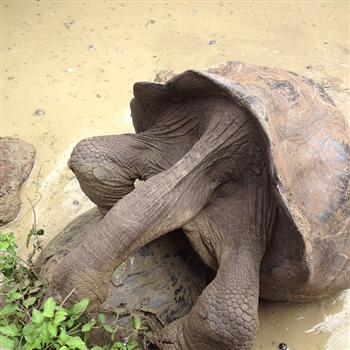 4. Giant Tortoises Have Very Loud Sex
In San Cristobal, I visited the Jacinto Gordillo Breeding Center of Giant Tortoises. While walking around, I couldn’t ignore an extremely loud, inhuman bellow/scream/cry that repetitively sounded every 15 seconds or so. What I thought was an animal dying was actually a pair of tortoises having sex. They were in a mud pond, and the male had to use a lot of strength to keep climbing on top of the female’s shell. Every time the poor thing thrust, his hands would slip again and he’d have to pull himself back up. The entire time, the female hid terrified in her shell.
Extra Fun Fact: The gender of the baby tortoise is determined by the temperature the eggs are incubated at. If eggs are incubated at 85.1 degrees Farenheit they will be female, and if they’re incubated at 82.4 degrees Farenheit they will be male.
Extra Extra Fun Fact: Baby tortoises must eat their own extrement, or they will die. It’s got certain vitamins and nutrients in it that are necessary to development.
5. Intestines And Blood Make For A Tasty Treat
San Cristobal has some interesting street food. Because many of the cheaper, local restaurants seem to shut down in the evening, I decided to try my luck with whatever the woman in the park was cooking for dinner. For $3, I got a huge helping of potatoes, goat intestines and grilled blood. While it may sound odd, it was actually quite delicious!
4. Giant Tortoises Have Very Loud Sex
In San Cristobal, I visited the Jacinto Gordillo Breeding Center of Giant Tortoises. While walking around, I couldn’t ignore an extremely loud, inhuman bellow/scream/cry that repetitively sounded every 15 seconds or so. What I thought was an animal dying was actually a pair of tortoises having sex. They were in a mud pond, and the male had to use a lot of strength to keep climbing on top of the female’s shell. Every time the poor thing thrust, his hands would slip again and he’d have to pull himself back up. The entire time, the female hid terrified in her shell.
Extra Fun Fact: The gender of the baby tortoise is determined by the temperature the eggs are incubated at. If eggs are incubated at 85.1 degrees Farenheit they will be female, and if they’re incubated at 82.4 degrees Farenheit they will be male.
Extra Extra Fun Fact: Baby tortoises must eat their own extrement, or they will die. It’s got certain vitamins and nutrients in it that are necessary to development.
5. Intestines And Blood Make For A Tasty Treat
San Cristobal has some interesting street food. Because many of the cheaper, local restaurants seem to shut down in the evening, I decided to try my luck with whatever the woman in the park was cooking for dinner. For $3, I got a huge helping of potatoes, goat intestines and grilled blood. While it may sound odd, it was actually quite delicious!
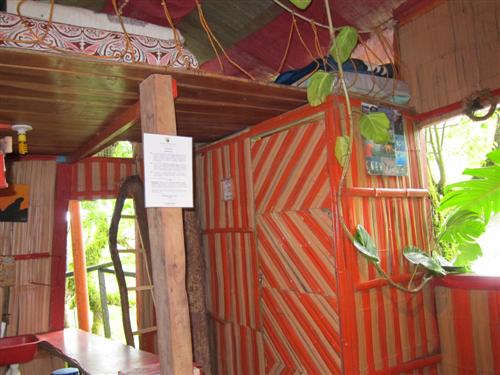 6. Tree Trunks Make For Excellent Sleeping Accommodations
On San Cristobal in the Galapagos, you’ll find a 300-year-old tree that’s also perfect for sleeping. It’s the tallest tree on the island, and it’s called El Ceibo. For $20 a night, visitors can choose to sleep in a fully-furnished treehouse, or climb down into the trunk to snooze in an underground cave dwelling – with a bed and toilet. There’s also an eco-friendly bar and restaurant made of thousands of recycled glass bottles.
7. It Is Possible For An Entire Community To Adopt An Eco-Friendly Lifestyle
What really struck me about the Galapagos Islands is how everybody is united in ecotourism. I’m not just talking about national park guides, but average citizens. They’re devoted to recycling, keeping trash off the streets and respecting the animals. I asked some of the locals how the government went about getting people to act so responsibly, and the answer was simply “they just tell them to”. Hopefully one day that strategy will work in other places, as well.
8. The Blue-Footed Booby Does Not Get Its Name From The Female Anatomy
In Spanish, the term “bobo” means “clown”. Because this bird is so clumsy, and has blue foot, the name fit perfectly.
9. Iguanas Can Swim
At least, they can in the Galapagos. Marine iguanas are one of the coolest animals I’ve ever seen. The first time I saw one, I actually thought it was a small crocodile.
6. Tree Trunks Make For Excellent Sleeping Accommodations
On San Cristobal in the Galapagos, you’ll find a 300-year-old tree that’s also perfect for sleeping. It’s the tallest tree on the island, and it’s called El Ceibo. For $20 a night, visitors can choose to sleep in a fully-furnished treehouse, or climb down into the trunk to snooze in an underground cave dwelling – with a bed and toilet. There’s also an eco-friendly bar and restaurant made of thousands of recycled glass bottles.
7. It Is Possible For An Entire Community To Adopt An Eco-Friendly Lifestyle
What really struck me about the Galapagos Islands is how everybody is united in ecotourism. I’m not just talking about national park guides, but average citizens. They’re devoted to recycling, keeping trash off the streets and respecting the animals. I asked some of the locals how the government went about getting people to act so responsibly, and the answer was simply “they just tell them to”. Hopefully one day that strategy will work in other places, as well.
8. The Blue-Footed Booby Does Not Get Its Name From The Female Anatomy
In Spanish, the term “bobo” means “clown”. Because this bird is so clumsy, and has blue foot, the name fit perfectly.
9. Iguanas Can Swim
At least, they can in the Galapagos. Marine iguanas are one of the coolest animals I’ve ever seen. The first time I saw one, I actually thought it was a small crocodile.
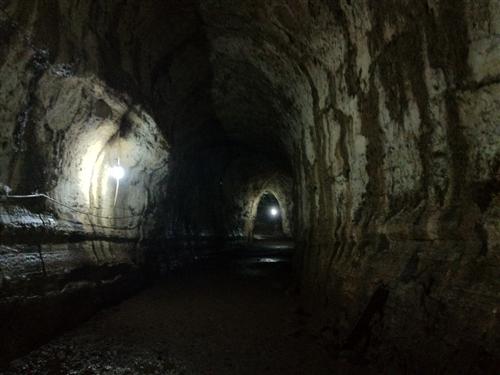 10. The Famous Lava Tunnels of Santa Cruz Were Discovered With The Help Of Decomposing Bodies
If you’ve ever heard people talk about the lava tunnels of Santa Cruz, there’s a good reason – they’re breathtaking. Created naturally from rapid flowing lava that dried when it touched air, you can actually walk through these magnificent tubes. The one thing that’s a bit morbid, however, is the way they were discovered. Apparently, the farmer who owns the property began losing a lot of cows. At this time, the opening to the lava tunnels, a land collapse, was covered by plants. It wasn’t until the cows bodies started decomposing and smell became overwhelming did he discover the opening.
11. Volcanoes Can Grow Other Volcanoes
Ever heard of the term “parasitic volcanoes”? They’re small volcanoes that grow out of bigger volcanoes, when molten lava that resides under solidified lava is forced out of weak sections from pressure. Seeing this phenomenon is one of many great reasons to visit the Galapagos Islands.
This post was made possible by a trip sponsored by Red Mangrove Aventura Lodge
10. The Famous Lava Tunnels of Santa Cruz Were Discovered With The Help Of Decomposing Bodies
If you’ve ever heard people talk about the lava tunnels of Santa Cruz, there’s a good reason – they’re breathtaking. Created naturally from rapid flowing lava that dried when it touched air, you can actually walk through these magnificent tubes. The one thing that’s a bit morbid, however, is the way they were discovered. Apparently, the farmer who owns the property began losing a lot of cows. At this time, the opening to the lava tunnels, a land collapse, was covered by plants. It wasn’t until the cows bodies started decomposing and smell became overwhelming did he discover the opening.
11. Volcanoes Can Grow Other Volcanoes
Ever heard of the term “parasitic volcanoes”? They’re small volcanoes that grow out of bigger volcanoes, when molten lava that resides under solidified lava is forced out of weak sections from pressure. Seeing this phenomenon is one of many great reasons to visit the Galapagos Islands.
This post was made possible by a trip sponsored by Red Mangrove Aventura Lodge 
Hi, I’m Jessie on a journey!
I'm a conscious solo traveler on a mission to take you beyond the guidebook to inspire you to live your best life through travel. Come join me!

Want to live your best life through travel?
Subscribe for FREE access to my library of fun blogging worksheets and learn how to get paid to travel more!

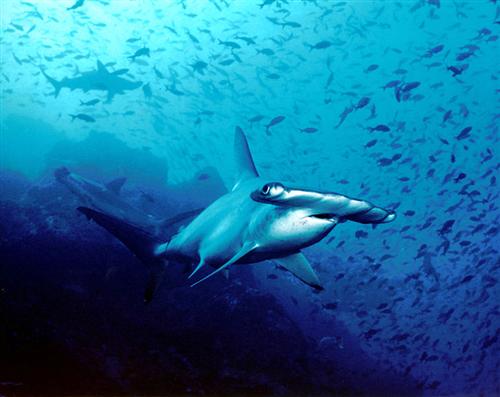
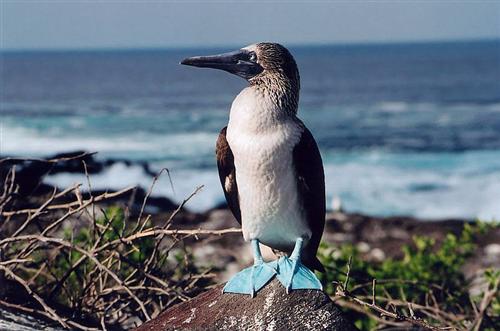

Great list…I didn’t know that about the lava tunnels, and I’ll be sure to check out El Ceibo during my time in San Cristobal! Cheers…
Thanks! 🙂 And you definitely should!